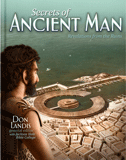
Lucy’s Child, “Selam,” from Ethiopia
The morphology of this new fossil discovery and the lack of transitional forms indicate that this fossil discovery has no relevance to human origins.
The reaction of the media is totally predictable when an important new fossil discovery is announced. Comments abound like: “This fossil confirms human evolution,” or “Now we will know much more about our evolutionary history,” or “This fossil is very human-like.” All these, and more, are said of the newest fossil discovery—the almost-complete skeleton of a three-year-old presumed female Australopithecus afarensis—the same species as the famous fossil called “Lucy.” The new fossil has been nicknamed “Selam,” meaning “peace.” Most evolutionists believe that this species, Australopithecus afarensis, is in our direct ancestry.
The term believe in the last sentence is key because there is no legitimate fossil pathway connecting the australopithecines with modern humans. Hence, it is deceptive and intellectually dishonest to make the bold claim that this or any other australopithecine is our ancestor.
This fossil was discovered in 2000. It has taken five years to extract most of it from the sandstone in which it was encased, and it will take several more years to extract all of it. The report on the fossil is published in the British journal Nature, 21 September 2006, pp. 296–301, and pp. 332–336. The lead researcher is Dr. Zeresenay Alemseged, an Ethiopian paleoanthropologist. This discovery is significant both because it is the first major one in which an African national was the leader, and because of the remarkable completeness and state of preservation of such an ancient specimen. The skeleton is complete except for the pelvis, the lowest part of the back, and parts of the limbs, which are missing. It is dated at 3.3 million years of age, and was found in the Dikika region of Ethiopia, just 2.5 miles from where the Lucy fossils were found. It is designated DIK-1-1.
The Nature article states: “On the basis of the many craniodental similarities to juvenile and adult Hadar specimens, we attribute DIK-1-1 to A. afarensis.” This is certainly a proper attribution because the article reveals more than fourteen similarities to Lucy and her kind, and six contrasts with another suggested human ancestor, Australopithecus africanus. Dr. Alemseged remarked, “I have a son who is nine months old. I also have a daughter who is 3.3 million years old” (The Independent, 25 September 2006). Thus, he and many others indicate that this find is a hominin that is closely related to humans. This belief is optimistically unrealistic—the facts reveal only that this fossil is an extinct ape.
There are six features of the fossil that are very different from humans—more like apes and especially like gorillas.
The Nature article claims that there are five features of this fossil that indicate that it could be evolving towards humans. However, there are six features of the fossil that are very different from humans—more like apes and especially like gorillas. Regarding the hyoid bone, necessary in human speech, Nature says: “It is most similar to that of juvenile African apes, and unlike that of modern humans.” Furthermore, “The shape of the scapula [shoulder bone] resembles the scapulae of juvenile and adult gorillas.” Researchers are divided as to whether this shoulder condition is an evolutionary holdover from Selam’s past evolutionary history or whether it indicates that Selam spent a great deal of her time in the trees. The claim is also made that the foot and leg bones show evidence of bipedality. However, many of the foot and leg bones are still in their sandstone casings, yet to be extracted.
There are three strong indications that Australopithecus afarensis in general, and that this fossil in particular, was not an obligate bipedal animal, but that it had another primary method of locomotion. First, the condition of the shoulder-bone, mentioned above, is much more like that of a gorilla, suggesting that this animal spent much time in the trees. Second, the bones of the only complete finger of this fossil are curved like those of a chimpanzee. (When born, chimpanzee fingers are only slightly curved, but they become more curved as the animal climbs trees, as is the finger of this fossil.) Third, the CT images of the inner ear of this fossil show that its semicircular canals were similar to those of the chimpanzee. In humans, these canals are filled with fluid and are essential to maintaining our balance as we walk on two feet. An extensive study in Nature (23 June 1994) by Fred Spoor, Bernard Wood, and Frans Zonneveld shows that the shape of these semicircular canals and its bony labyrinth are structured to allow the proper posture and balance for bipedal locomotion both in modern and fossil Homo sapiens (including all Neandertals) and all Homo erectus fossils. All other primates—living and fossil, including Australopithecus afarensis—lack the proper canal and bony labyrinth morphology for proper bipedal locomotion.
There is no doubt that “Selam” is a remarkable fossil of an extinct ape. The much more serious problem for evolutionists is to connect the lineage of this fossil, or any australopithecine, with humans. There is a complete lack of evolutionary transitions leading to humans. This is something that the reader can check out for himself. As I have mentioned elsewhere, since 1990, every chart dealing with human evolution shows either question marks or dotted lines at the spot of the alleged transition from the australopithecines to humans, thus indicating great uncertainty. This is true of charts in scientific journals, books on human evolution, and articles in the popular press. Among many uncertain areas, one area always involves the alleged “missing link” Homo habilis.
Proof of this condition is a source easily accessible to the reader: National Geographic, February, 1997. This article on human evolution contains two charts. The first is by Bernard Wood (George Washington University), perhaps the world’s leading authority on evolutionary phylogeny (relationships). Wood’s chart on human evolution has 15 question marks in it. The other chart is by Philip Tobias (University of the Witwatersrand, South Africa), one of the “inventors” of Homo habilis (together with Louis Leakey). Tobias’ chart on human evolution has eight question marks in it. The certainty that humans evolved as expressed in the popular press and by scientists reflects their belief and their philosophy, not the factual evidence.
It is of interest that the Nature issue dealing with “Selam” has a new human evolution chart by none other than Bernard Wood (p. 279). Conditions have not changed regarding the disarray and confusion regarding all of the fossils in the alleged transitional taxon Homo habilis. But Wood does a remarkable job of camouflaging that fact. He has apparently grown weary of having to insert question marks in human evolution charts. Thus he has a new strategy. In his new bar chart, he names no specific fossils in the stages from Australopithecus afarensis all the way to modern humans. Instead, at the most strategic spot of all—the transition from the australopithecines to modern humans—he has two magenta bars labeled “Transitional hominins.” He does not name a specific fossil or type of fossil. This is not science; this is science fiction! Wood is merely expressing his personal faith in human evolution. And this is the state of human evolution today. If there are no legitimate transitional fossils linking humans to the australopithecines, then Selam is not one of our ancestors. It is just a very fascinating extinct fossil ape.
Recommended Resources

Answers in Genesis is an apologetics ministry, dedicated to helping Christians defend their faith and proclaim the good news of Jesus Christ.
- Customer Service 800.778.3390
- © 2025 Answers in Genesis




